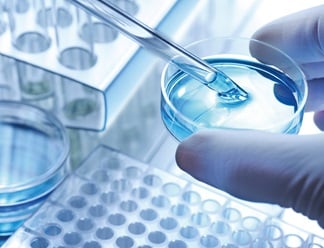Surface cleaning describes the process by which soiling is removed fromsurfaces "using water with cleaning-enhancing additives (e.g. detergentsor enzymatic products)" [1]. Surfaces in hospitals and other medicalfacilities must be assessed against the background of infection risks, as theycan be an integral part in transmission of nosocomial pathogens [1]. Properhospital cleaning is therefore an indispensable component of a multi-barriersystem for infection prevention [2]. On the one hand, professional cleaning reducesthe germ load on surfaces by up to 50-80% [1]; on the other hand, theeffectiveness of disinfectants on soiled surfaces can be significantly lowerdue to the organic material [3].
Requirements for hospital cleaning in Germany are laiddown in DIN 13063 [4]. DIN 13063 formulates three basic goals: visually cleansurfaces, a sufficient reduction in the number of microorganisms, andprevention of their spread to other surfaces. According to DIN 13063, thesegoals can be achieved by meeting quality requirements in three different areas:Structural quality, process quality, and result quality. The requirements forstructural quality are, for example, the condition of the floors orrequirements for the equipment of the cleaning staff. The requirements forprocess quality define demands regarding the execution of the cleaning itself. Therefore,particularly risky surfaces such as bedsteads must be cleaned daily. Therequirements for the quality of results define methods for checking thecleaning result, such as microbiological sampling.
Cleaning implementation
The cleaning process can be carried out in fourconsecutive steps: 1. "look", 2. "plan", 3."clean", and 4. "dry" [5]. In the first step, the cleanershould make a visual inspection to get an overall impression of the area to becleaned. Where are contaminants present and how severe are they? The next stepshould be to prepare for cleaning, i.e. organise the room or area so thatcleaning can be done efficiently. For example, all surfaces, which requirecleaning, must be cleared first. In the third step, soiling should be removedby wiping with cloths/mop covers soaked in detergent. The last step involvesdrying of the cleaned surfaces. This can be done either by using dry cloths orby evaporation.
Risk assessment
Risk assessment isthe basis of effective cleaning and disinfection in health care (see Fig. 1).It is based on three inseparable cornerstones: the risk profiles of the patient(I), the surface (II), and the pathogen (III). For the analysis, thevulnerability of the patient, the frequency of hand or skin contacts with thesurface, and their probability of surface contamination are assessed. Thepersistence, the transmission paths, and the clinical relevance of thepathogens are also taken into account. In the second step, appropriate measuresare determined, which are covered either by routine cleaning and disinfectionor targeted cleaning and disinfection [3].

